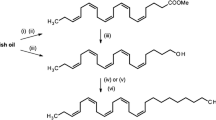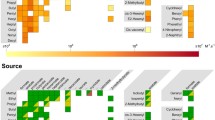Abstract
Three volatile alkyl-thio-trifluoro propanones inhibiting the esterase in olfactory sensilla of the silkmoths Antheraea polyphemus and A. pernyi were used to test the hypothesis that enzymatic pheromone degradation is responsible for the decline of the receptor potential after pheromone stimulation. Test stimuli were the pheromone components (E,Z)-6,11-hexadecadienyl acetate, a substrate for the sensillar esterase, and (E,Z)-6,11-hexadecadienal, not degraded by the esterase. Each compound acts on a separate type of receptor cell. In both receptor cell types the trifluoro propanones caused a partially reversible reduction of sensitivity as indicated by smaller receptor potential amplitudes and lower nerve impulse frequencies. Since application of the esterase inhibitors did not prolong the decline of the receptor potential of the acetate cell, the esterase is not responsible for the rapid pheromone deactivation. When the trifluoro propanones were applied after the pheromone at high concentrations, they rapidly inhibited (repolarized) both receptor cell types. Experiments with local application of trifluoro propanones revealed that the inhibitory effect spreads within seconds along the length of the sensillum. The inhibition of the electrophysiological responses might be due to an antagonistic action of the trifluoro propanones at the pheromone-binding sites, either at the receptor molecules or at the pheromone-binding protein.
Similar content being viewed by others
Author information
Authors and Affiliations
Additional information
Accepted: 4 February 1998
Rights and permissions
About this article
Cite this article
Pophof, B. Inhibitors of sensillar esterase reversibly block the responses of moth pheromone receptor cells. J Comp Physiol A 183, 153–164 (1998). https://doi.org/10.1007/s003590050243
Issue Date:
DOI: https://doi.org/10.1007/s003590050243




